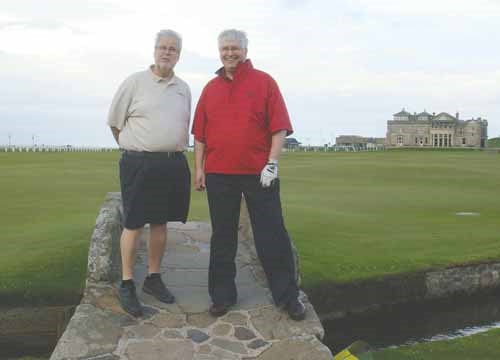If you are a golfer one course stands out among all the world's golfing options, the 'Old Course' at St. Andrew's likely stands out above all others.
Dick DeRyk of Yorkton said the course is a near "Mecca" for golfers and in May he made the pilgrimage to Scotland to play the historic links, which dates back to 1400 A.D.
"It's the Mecca of golf. It's presumably, by legend, the first golf course," he said. "If you're serious about golf it's on your bucket list."
The entire trip, which had DeRyk in Scotland for a week was about the game.
"It was an absolute golf trip, a single purpose," he said, adding he played five courses in six days.
But the old course at St. Andrew's was the trip highlight.
DeRyk said there was a definite sense of history walking the course, in particular when crossing Swilcan Bridge in the 18th hole.
"Virtually every professional and amateur golfer has crossed that bridge," he said, adding the likes of Arnold Palmer, Jack Nicklaus and Bobby Jones had been there before him. " Everybody has stood on this Swilcan Bridge, and here I am."
The trip idea actually originated with DeRyk's friend David Lloyd in Edmonton.
When Lloyd's mother died she had left him "money specifically for him to go play the old course at St. Andrew's," said DeRyk, adding he was asked if he wanted to "take a little trip and play some golf in Scotland."
For DeRyk, an avid golfer who gets out on a local course three, or four times a week, it was an offer he said only took a couple of minutes to accept.
Of course to play the fabled course is not as simple as walking up and selecting a tee-off time.
DeRyk said on Jan. 10, at 10 Greenwich Mean Time any tourists wanting to play the course in the following year must email their requests, with the window of time they are in Scotland.
"It's first come, first serve," he said.
Once confirmation of a tee-off is received, you send in payment ($340), said DeRyk. If you miss the time for any reason, including rain, the fee is lost.
"There are no rain-checks, no refunds," he said.
The fee actually covered two rounds of golf, the old course, and the new 18-holes at St. Andrew's.
"It's fairly reasonable for courses with this sort of reputation," said DeRyk.
There are a few additional costs associated with golf in Scotland, beginning with hiring a caddy.
"No carts are allowed on that course," he said, adding even pull carts are restricted until after noon.
"Caddies were 45 pounds a round plus tip."
DeRyk said hiring a caddy was part of the experience of playing the old course, adding having someone who knew the course was indispensable.
"You'd be buffaloed figuring out that golf course if you didn't have somebody who knew it," he said.
As for the course, it might be described best as sparse. DeRyk said it's "wide open, no trees," with much of the course hugging the shore of the Atlantic Ocean.
The fairways are hard, and the rough is thorned-gorse bush.
"The golf courses there are not manicured," said DeRyk, adding at St. Andrew's "none of the golf course has seen a bulldozer or earthmover."
As a side note, DeRyk said as coveted as tee-off times are on the old course, on Sundays there is no golf as the course is "open for the townspeople to walk."
Besides the general care of Scottish courses, DeRyk said he quickly learned the game there is one played in the wind.
"It was a bit of a surprise to me," he said, adding he had generally believed "if you can't golf in the wind you can't golf in Saskatchewan." He said a Prairie wind paled compared to that he faced on his trip. "The wind in Scotland is brutal. The only word to describe it is brutal."
DeRyk said on high flying drives he could see the wind carrying the ball back toward him, and in one instance he was readying for a 10-foot putt on the green and the caddy said "hit it a little harder you're into the wind."
As for his scores, DeRyk said both the old and new courses at St. Andrew's are par-72, although the new one is longer. He shot a 93 on the old course and a 97 on the new.
On Glen Eagles, a course lying inland a bit, with a few trees, DeRyk had his best outing of the trip.
"It's a tougher course as far as rating," goes, but he still recorded an 83, which he added "is better than my handicap."
"That day I was absolutely on my game," he said, adding with a veteran caddy of 16-years making shot suggestions, he had a great game. "Ninety per cent of the time I hit it exactly where he said to hit it."
King's Barns was one of Scotland's newer courses DeRyk played.
"It's a very traditional design, but again not manicured like North American courses," he said.
The fifth course of the trip was Crail Balcomie.
As connected to the history of golf as DeRyk was playing the old course, he said he would not make it a regular pilgrimage even if he could.
"If I go back to Scotland for more golf I wouldn't play it again," he said, although he added on a first trip there is a near "obligation" to visit St. Andrew's. He said before making the trip the course would have certainly been on his dream golf destination.




